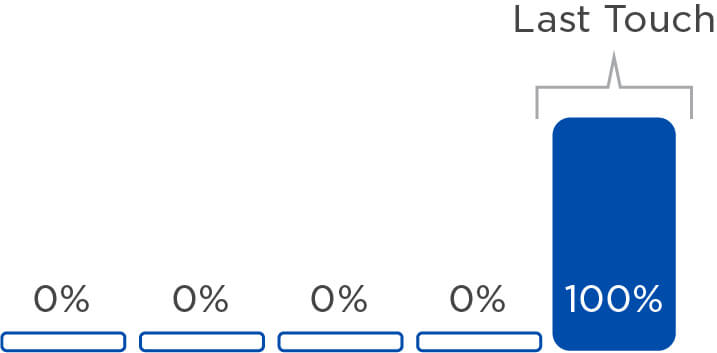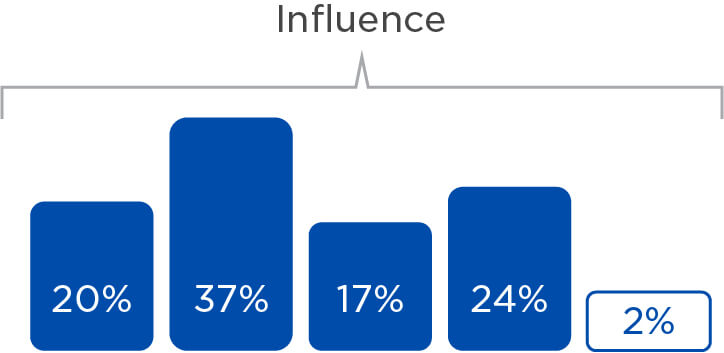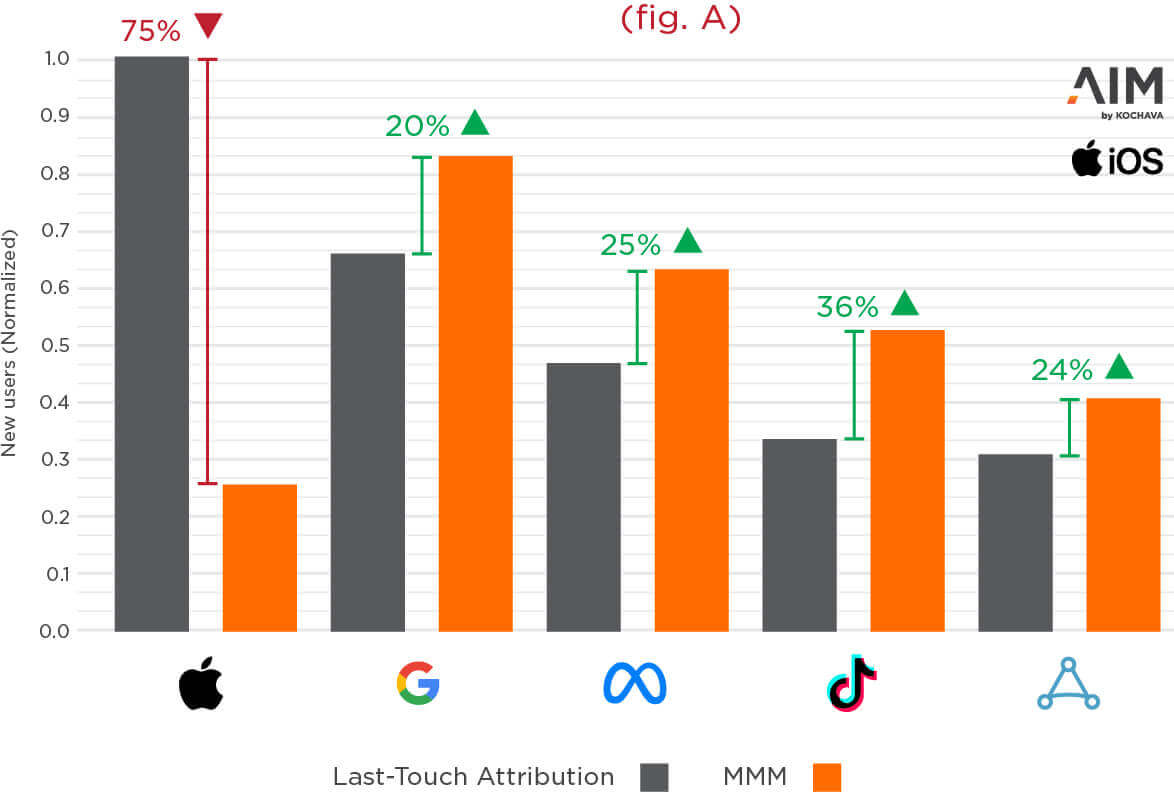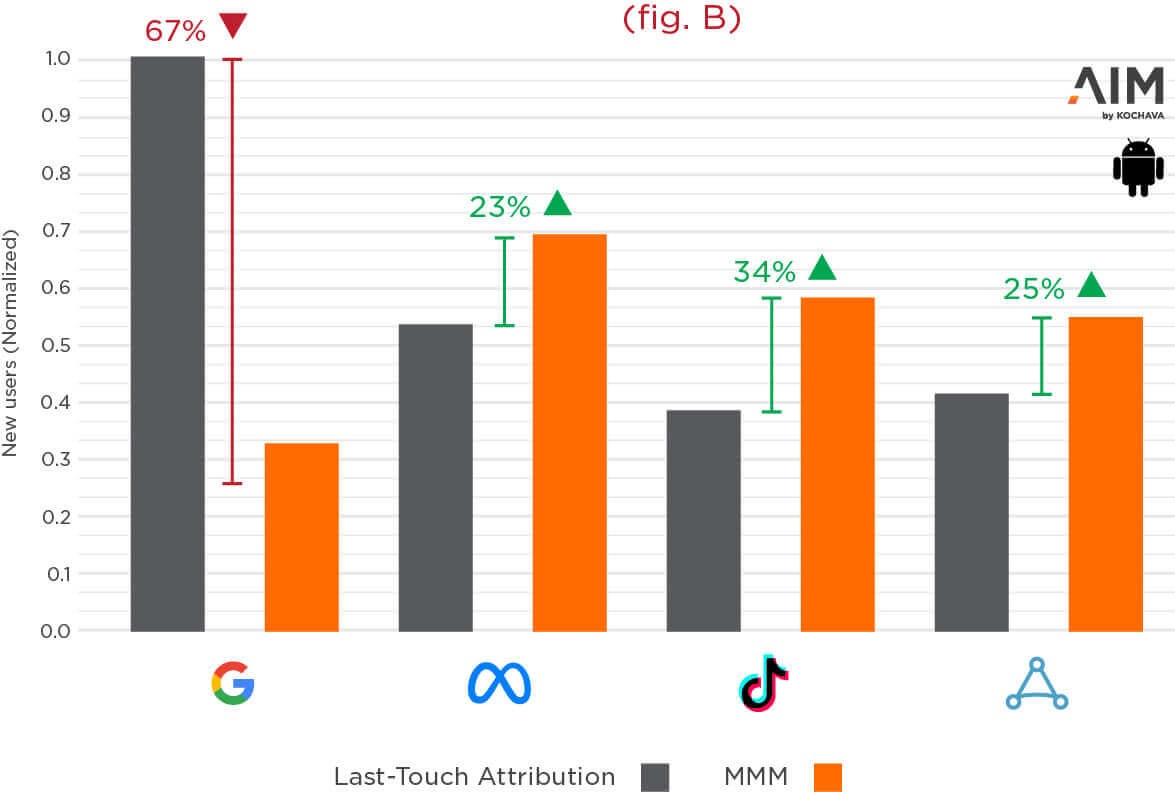LTA vs. MMM: What’s really driving conversions?
TL;DR Summary
Traditional last-touch attribution (LTA) often misrepresents which marketing channels truly drive app conversion incrementality. While LTA credits the last interaction (e.g., an Apple Ad), marketing mix modeling (MMM) reveals that channels like video and social media often create substantial upstream demand, significantly impacting overall incremental growth.
Data from a Kochava analysis of first-time app orders for 16 brands across major advertising platforms shows that Apple Ads (iOS) and Google (Android) are overattributed by LTA, while other platforms are undervalued. The key takeaway is that MMM provides a more holistic and prescriptive view for optimizing budget allocation and campaign strategy for maximum incremental impact.
Your user acquisition team just wrapped their quarterly budget review, and the data tells a compelling story. Apple Ads (formerly Apple Search Ads) is absolutely crushing it on iOS—delivering the majority of attributed in-app orders at an impressive cost per acquisition. The logical next step? Double down on Apple Ads spend and maybe trim some of those “underperforming” video campaigns on TikTok and Meta.
But what if this seemingly logical decision is based on fundamentally limited data? What if the channel getting all the credit is simply the last stop on a journey that began elsewhere?
This is the reality faced by marketers industry-wide, where last-touch attribution (LTA) continues to drive budget allocation decisions despite mounting evidence that it tells only part of the larger story. The rise of next-generation, agile marketing mix modeling (MMM) reveals paradigm-shifting truths about which channels truly drive incremental growth—and the findings are reshaping how savvy marketers think about performance.
LTA and MMM
Before we dig in further, let’s lay out some key differences between last-touch attribution (LTA) and marketing mix modeling (MMM).
Last-Touch Attribution (LTA)
- Simple method that measures only the last touch
- Assigns 100% credit to the last touch
- Tends to overvalue bottom-of-funnel media

Marketing Mix Modeling (MMM)
- Sophisticated method using powerful statistical modeling
- Utilizes advanced data science and machine learning
- Measures full media funnel and external factors

App Conversion Incrementality: LTA vs. MMM Analysis
Background
The Kochava AIM (Always-On Incremental Measurement) team recently conducted an analysis focusing specifically on app user acquisition campaigns. The goal was simple yet revealing: Compare how MMM and LTA assign credit for first-time app orders across major advertising platforms.
Scope
We analyzed media mix data across 16 brands in North America.
Methodology
We normalized the network with the highest LTA-attributed new user count—Apple Ads on iOS and Google on Android—to 1.0, then indexed the other networks relative to these benchmarks. While this represents a simplified view of MMM’s sophisticated modeling capabilities—which account for myriad factors including seasonality, collinearity between channels, and cost curves—it highlights the fundamental differences in how these measurement approaches understand campaign performance.
Results
The results were eye-opening.
iOS Results: The Apple Ads Mirage
On iOS, our analysis revealed a startling discrepancy: Under LTA, Apple Ads appeared to dominate the field—exactly what you’d expect given its prime real estate atop App Store search results. However, when we applied MMM analysis to the same data, Apple Ads’ true incremental impact was 75% lower than what LTA suggested.
This massive difference exposes a fundamental limitation in last-touch thinking. After users search for your app by name and tap your Apple Ad, LTA dutifully credits Apple Ads with the conversion. But MMM reveals the more holistic origin story: Many of these users were already planning to convert—they didn’t need convincing.
Meanwhile, upstream channels appearing to underperform under LTA, looked at through the MMM lens, told us a completely different story. Google, Meta, TikTok, and AppLovin—platforms marginalized by LTA—demonstrated strong incremental performance when measured holistically. The data showed impressive increases in MMM attribution compared to LTA:
- Google campaigns were undervalued by 20%
- AppLovin by 24%
- Meta by 25%
- TikTok by 36%

Figure A: iOS attribution comparison: LTA vs. MMM reveals dramatic overattribution of Apple Ads and underattribution of video/social channels.
Android Results: Google’s Attribution Mirage
Android presented an equally dramatic case: Google app campaigns, which appeared dominant under LTA, saw their attributed impact drop by 67% when measured via MMM. This dramatic discrepancy mirrors the iOS findings.
The pattern held consistent across channels. Under MMM,
- Meta showed 23% higher attribution
- AppLovin revealed 25% more true impact
- TikTok demonstrated 34% stronger incremental performance

Figure B: Android attribution comparison: Google app campaigns show 67% overattribution with LTA measurement.
DISCLAIMER
It is important to note that in both cases the data represents directional trends observed across 16 distinct client cases and is not prescriptive to you or your specific brand. Every business model, customer journey, and channel mix is unique. This same analysis can be tailored for your specific brand and media mix by contacting info@aimplatform.io.
Understanding the Attribution Difference
It is important to note that neither measurement method is right or wrong—they’re simply answering different questions. LTA tells you which channel appeared last in the customer journey, providing clear accountability for closing conversions. This remains valuable for understanding immediate conversion drivers and optimizing lower-funnel performance. MMM, however, reveals which channels influenced the conversion over the entire customer journey. Both perspectives have value, but understanding the distinction is crucial for optimal decision-making.
The Upstream Influence Effect
Full attribution comprehension requires recognizing how the modern consumer experience actually unfolds. As digital advertising has evolved, the customer journey has become increasingly complex, with consumers leaning into multiple touchpoints across video platforms, social media, and search before completing a purchase.
Rich media environments—particularly video-format channels like YouTube, TikTok, and Meta—excel at shaping user intent early in the discovery process. A potential customer might view a compelling video ad during a social media scroll, see it again the same evening during their favorite streaming show, and then download and explore your app a few days later at the cafe while waiting for their cappuccino. LTA assigns credit to the search campaign for the conversion, but MMM recognizes that the lion’s share of the influence actually happened upstream through the initial video exposures.
The upstream influence effect explains why channels focused on awareness and consideration consistently outperform in MMM analysis compared to LTA. The search campaign didn’t create demand—it simply captured demand created elsewhere.
Beyond Attribution: The Strategic Implications
This shift in perspective is powerful. These findings expose a critical blindspot in how many UA teams allocate budgets. If you optimize solely based on LTA data, you’re likely
- Overinvesting in search campaigns that capture rather than create demand
- Underinvesting in video and social channels that drive actual influence
- Missing incremental opportunities in channels that appear less effective through a last-touch lens
The implications extend beyond budget allocation to fundamental campaign strategy. Traditional funnel thinking suggests that lower-funnel activities such as search should receive the greater share of performance marketing budgets. But MMM reveals that upper-funnel investment in awareness and consideration often drives more incremental value per dollar spent.
The Evolution of Measurement: Why MMM Complements Attribution
You might be wondering, “We already run incrementality tests. Why do we need MMM?”
The answer lies in the fundamental difference between diagnostic and prescriptive measurement. Incrementality testing is diagnostic—it tells you what happened in one channel at one point in time.
MMM is both diagnostic and prescriptive, revealing
- What worked across all channels simultaneously
- How much value the next dollar brings in each channel
- Where to invest next for maximum incremental impact
The distinction becomes important when managing modern UA strategies spanning multiple channels and touchpoints. While incrementality tests can tell you whether your TikTok campaign drove lift, MMM shows you how the campaign interacted with your search, display, and connected TV efforts to drive overall performance.
The Path Forward: Measurement That Matches Reality
The data is clear: LTA provides a confined view of what drives app conversion incrementality. As digital marketing continues to evolve, organizations that embrace MMM alongside traditional attribution stand to gain significant competitive advantages. Instead of pouring budget into channels that simply capture conversions, marketers can invest in channels that genuinely influence them. This is where the real performance unlock lies—and it’s already transforming how forward-thinking user acquisition teams approach their craft. In a world where every marketing dollar must work harder than ever, understanding true incremental impact isn’t just a “nice to have”—it’s essential for sustainable growth.
Transitioning from LTA-dependent optimization to MMM-informed strategy requires both organizational alignment and technological infrastructure. Here are some steps to get you going:
- Establish MMM capabilities such as AIM by Kochava that can analyze your full marketing mix, not just individual channels in isolation.
- Redefine success metrics to focus on incremental impact rather than only last-touch conversions.
- Restructure budget allocation processes to account for channels that drive influence rather than just capturing demand.
- Train teams to think in terms of customer journeys rather than individual touchpoints.
Ready to discover what’s really driving your app installs? The uncomfortable truth might be exactly what your performance needs to reach the next level.
Want to experience the power of marketing mix modeling for reshaping your user acquisition strategy? AIM by Kochava provides agile, next-generation MMM designed specially for mobile marketers. Reach out for a strategic consultation and custom incrementality analysis for your brand! Contact our team to learn how our MMM solution can unlock hidden performance in your campaigns.




